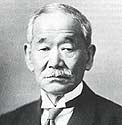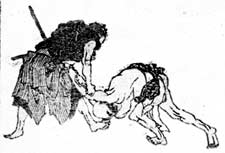
Sometimes it's better to be lucky than good:
Ten thousand flowers in spring, the moon in autumn, a cool breeze in summer, snow in winter. If your mind isn't clouded by unnecessary things, this is the best season of your life.
~ Wu-men ~




 Humphries (L) and Mendoza (R) at Stilton, 1789.
Humphries (L) and Mendoza (R) at Stilton, 1789.Please note that comments in square brackets, [thus], are my additions.
MENDOZA'S TREATISE, WITH HIS SIX LESSONS
In the preceding pages is given a system of Boxing as generally practised by the most celebrated pugilists of the present day; we shall now add Mendoza's treatise on the subject, which, as the reader will observe, is comprised in a very short compass, and differs not very materially in general principles from the foregoing. The six lessons that form an essential part of his treatise are however well worth the notice of the reader, and an attention to them must be a very material help in acquiring a knowledge of the science.
The first principle to be established in Boxing (says he) is to be perfectly a master of the equilibrium of the body, so as to be able to change from a right to a left handed position; to advance or retreat striking or parrying; and throw the body either forward or backward without difficulty or embarrassment.


With the range of possible definitions applicable to each character, one soon recognises the degree of inadequacy of the unsophisticated term study when applied to shugyo.
To the martial artist native speaker of Japanese, shugyo has far deeper resonance than study suggests. For example, the renowned "father of modern karate-do", Gichin Funakoshi was known to venture outside to take advantage of typhoons for training purposes, typhoons that are noted for being particularly ferocious around his island home of Okinawa. Tales have it that whilst holding a tatami mat to create resistance to the howling winds, Funakoshi would test the strength of his stances upon the rooftops. (3) The significance of this tale to our discussion of shugyo is not the perceived eccentricity of Funakoshi and his peculiar penchant for training in extremes of weather. Rather, the tale illustrates well, the ability for a determined mind to employ any circumstance to further an understanding of the true nature of that which is being studied, the way of karate in our case.
Chito Ryu Karate founder Tsuyoshi Chitose, known reverently as O'sensei, was himself was required by his first teacher, Arakaki, to study the same kata (a standard routine of karate techniques), Seisan , for seven years before being introduced to another. Those unfamiliar with shugyo will doubtless be impressed by the depth of commitment and concentration displayed by O'sensei, a level of dedication rarely seen even in adults whilst at the mere age of seven. This last comment at first glance may be misleading in that it appears to make light of the efforts and achievements of the young O'sensei. Please consider momentarily the alternate proposition that O'sensei, Funakoshi and the multitudes of martial arts immortals not referred to here were in fact NOT inherently special.
Consider, instead, that all of the individuals above were ordinary people, the same as everybody else in every aspect besides obvious personal circumstances (language, nationality and the like). It would then follow logically that ANY other person could repeat their feats. Indeed with the right mindset it should be understood not only could any person repeat their feats, but in fact build upon them. Actually, the only thing separating such perceived greatness from the masses is hard work and an unfailing belief in the fact that the goal will be achieved. The important point to consider here is that one need not focus upon the glorified achievement of such individuals, for to do so risks deification of the personality, in turn dooming all others following their example to fall short of the ideal (the rest of us after all are mere mortals) . Far more valuable to those who wish to follow the Masters is to gain an understanding of the means by which they gained their greatness, and this in every case without exception was, is and always will be shugyo.
...





KOMODO ISLAND, Indonesia – Komodo dragons have shark-like teeth and poisonous venom that can kill a person within hours of a bite. Yet villagers who have lived for generations alongside the world's largest lizard were not afraid — until the dragons started to attack.
The stories spread quickly across this smattering of tropical islands in southeastern Indonesia, the only place the endangered reptiles can still be found in the wild: Two people were killed since 2007 — a young boy and a fisherman — and others were badly wounded after being charged unprovoked.
Komodo dragon attacks are still rare, experts note. But fear is swirling through the fishing villages, along with questions on how best to live with the dragons in the future.
Main, a 46-year-old park ranger, was doing paperwork when a dragon slithered up the stairs of his wooden hut in Komodo National Park and went for his ankles dangling beneath the desk. When the ranger tried to pry open the beast's powerful jaws, it locked its teeth into his hand.
"I thought I wouldn't survive... I've spent half my life working with Komodos and have never seen anything like it," said Main, pointing to his jagged gashes, sewn up with 55 stitches and still swollen three months later. "Luckily, my friends heard my screams and got me to hospital in time."
Komodos, which are popular at zoos in the United States to Europe, grow to be 10 feet (3 meters) long and 150 pounds (70 kilograms). All of the estimated 2,500 left in the wild can be found within the 700-square-mile (1,810-square-kilometer) Komodo National Park, mostly on its two largest islands, Komodo and Rinca. The lizards on neighboring Padar were wiped out in the 1980s when hunters killed their main prey, deer.


By Jigaro Kano
Translated by Rev. T. Lindsay, April 18, 1888
Submitted by Stan Hart
Editor’s Note: This is the first part of an article originally written by Jigaro Kano, the founder of modern Judo (Jiudo). Part 1 investigates the origin of Jiujutsu (Jujutsu). There is also a glossary provided by Stan Hart, who translated the Japanese Kanji (characters) used in the original text. Part 2 discusses various schools and relates some stories about old Jiujtsu masters. The romanization of Japanese words that appear in this article are based upon the spellings used in England at the time the article was written.
In feudal times in Japan, there were various military arts and exercises by which the Samurai classes were trained and fitted for their special forms of warfare.
Among these was the art of Jiujutsu (1), from which the present Jiudo (2) has sprung up. The word Jiujutsu may be translated freely as the art of gaining victory by yielding or pliancy. Originally, the name seems to have been applied to what may best be described as the art of fighting without weapons, although in some cases short weapons were used against opponents fighting with long weapons.
 Although it seems to resemble wrestling, yet it differs materially from wrestling as practiced in England, its main principle being not to match strength against strength, but to gain victory by yielding to strength.
Although it seems to resemble wrestling, yet it differs materially from wrestling as practiced in England, its main principle being not to match strength against strength, but to gain victory by yielding to strength.
Since the abolition of the feudal system the art has for some time been out of use, but at the present time it has become very popular in Japan, though with some important modifications, as a system of athletics, and its value as a method for physical training has been recognized by the establishment of several schools of Jiujutsu and Jiudo in the capital.